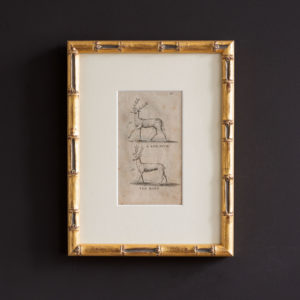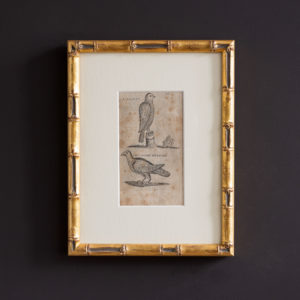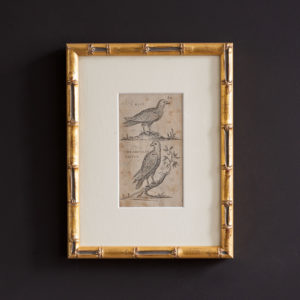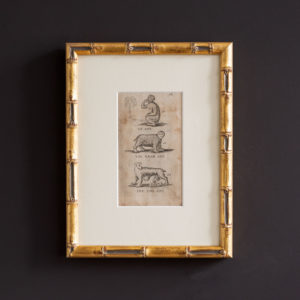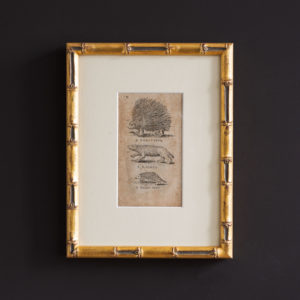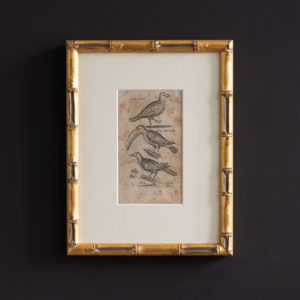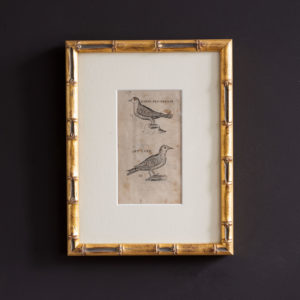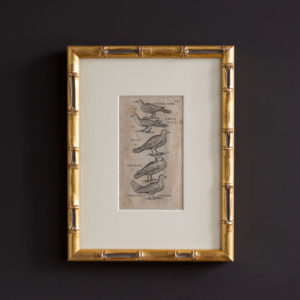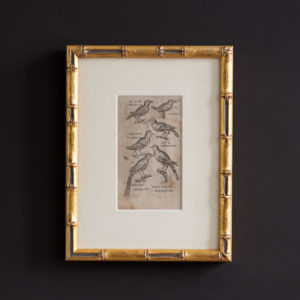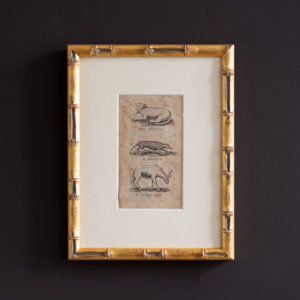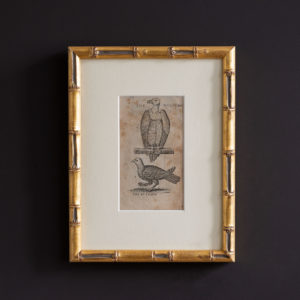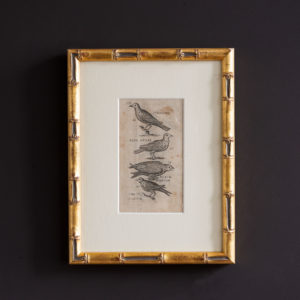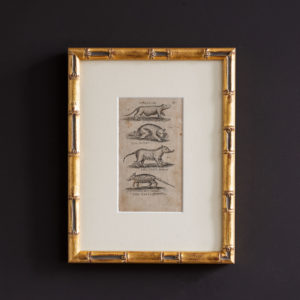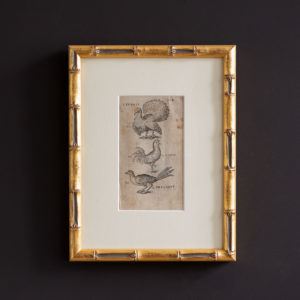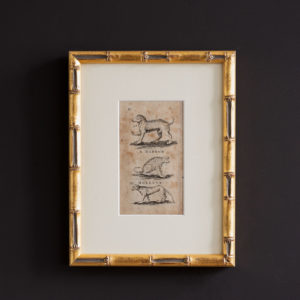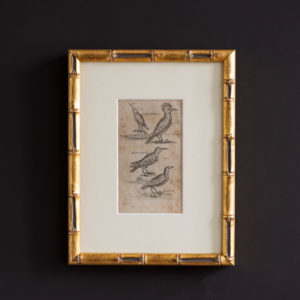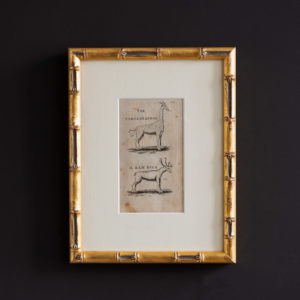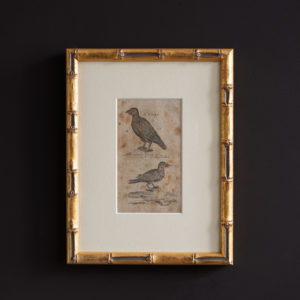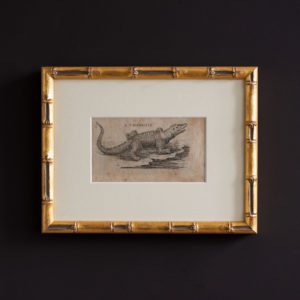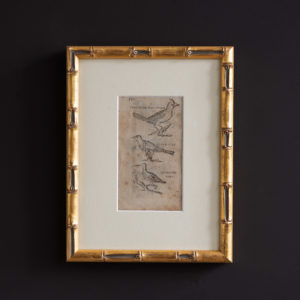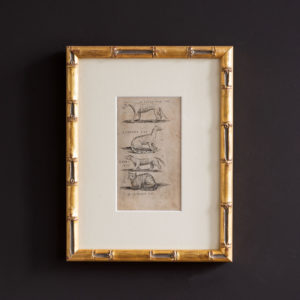255 items found
Page 1 of 3
-
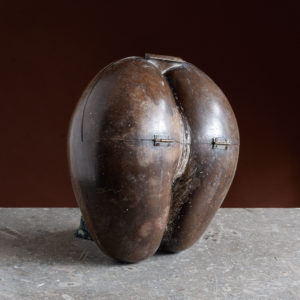
Coco de Mer nut
£850 -
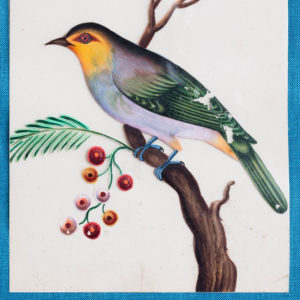
Set of Indian orthniological paintings on mica
£660 set of sixSet of Indian orthniological paintings on mica
Mica is a transparent mineral composed of complex mixtures of potassium silicates. The variety of mica used most frequently by these Indian artists is Muscovite (H2KAl3 Si04)3 which is found widely throughout south India. The mica is formed between strata of granite and the transparency of the material is a result of the heat and pressure created between the layers of rock during formation. Mica consists of many interlocking platelets, resulting in a laminar structure which can be split easily into thin sheets.£660 set of six -
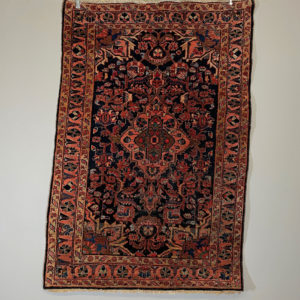
An antique Josan Sarouk rug
£525An antique Josan Sarouk rug
the indigo field with polychrome foliate pattern and spandrels with pink central medallion; stiff handle, low pile in places; cleaned and ready to lay,£525 -
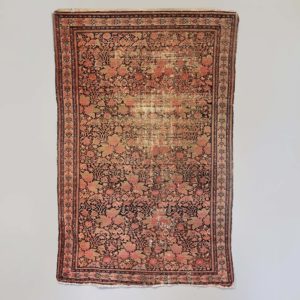
An old Malayer rug,
£450An old Malayer rug,
the all-over foliate pattern in pink and pale green on a dark ground; low all over, to the foundation in places, with restorations; wear to ends and sides; cleaned,£450 -
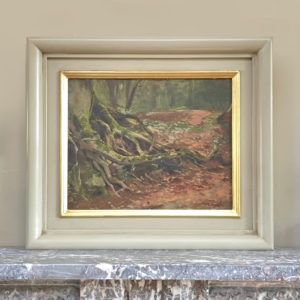
A woodland scene oil on panel,
£350A woodland scene oil on panel,
a study of contorted tree roots on the woodland floor, presented in a newly made parcel gilt, waxed and painted pine frame,£350 -
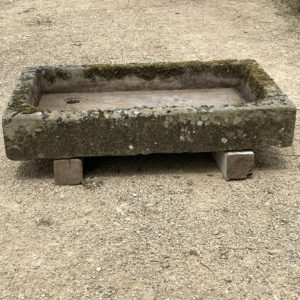
An old sandstone sink
£340An old sandstone sink
neatly carved, with radius corners to the front of the basin; attractively weathered,£340 -
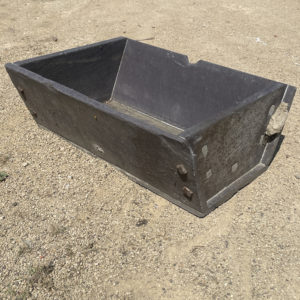
An old slate slab laundry basin
£320 -
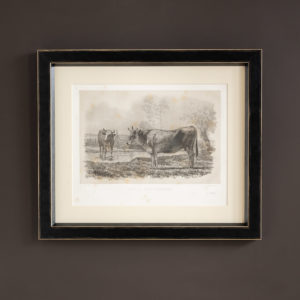
Original lithographs of Cattle Breeds published 1862, ‘Vache Parthenaise’,
£300 eachOriginal lithographs of Cattle Breeds published 1862, ‘Vache Parthenaise’,
Printed by Lemercier of Paris.£300 each -
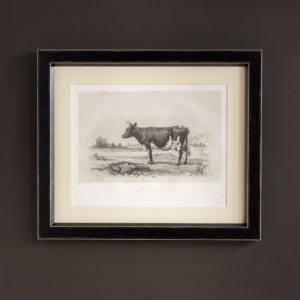
Original lithographs of Cattle Breeds published 1862, ‘Vache D’Ayr’,
£300 eachOriginal lithographs of Cattle Breeds published 1862, ‘Vache D’Ayr’,
Printed by Lemercier of Paris.£300 each -
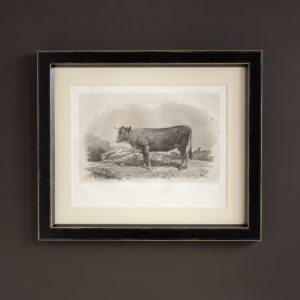
Original lithographs of Cattle Breeds published 1862, ‘Vache Garonnaise’,
£300 eachOriginal lithographs of Cattle Breeds published 1862, ‘Vache Garonnaise’,
Printed by Lemercier of Paris.£300 each -
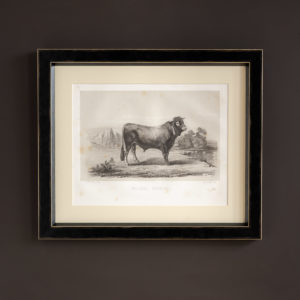
Original lithographs of Cattle Breeds published 1862, ‘Taureau Bazadais’,
£300 eachOriginal lithographs of Cattle Breeds published 1862, ‘Taureau Bazadais’,
Printed by Lemercier of Paris.£300 each -
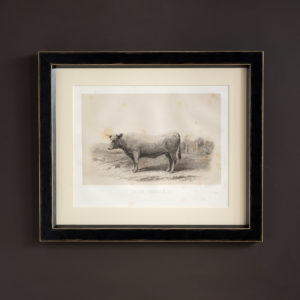
Original lithographs of Cattle Breeds published 1862, ‘Vache Charolaise’,
£300 eachOriginal lithographs of Cattle Breeds published 1862, ‘Vache Charolaise’,
Printed by Lemercier of Paris.£300 each -
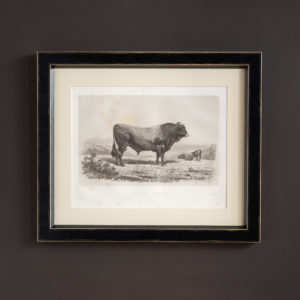
Original lithographs of Cattle Breeds published 1862, ‘Taureau Gascon’,
£300 eachOriginal lithographs of Cattle Breeds published 1862, ‘Taureau Gascon’,
Printed by Lemercier of Paris.£300 each -
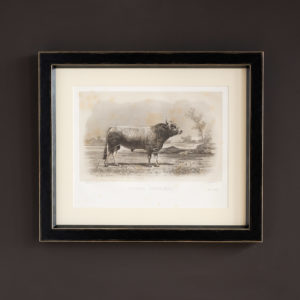
Original lithographs of Cattle Breeds published 1862, ‘Taureau Parthenais’,
£300 eachOriginal lithographs of Cattle Breeds published 1862, ‘Taureau Parthenais’,
Printed by Lemercier of Paris.£300 each -
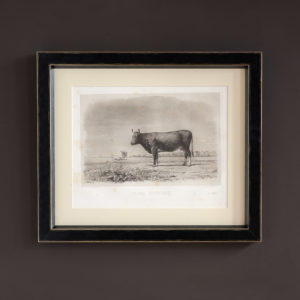
Original lithographs of Cattle Breeds published 1862, ‘Vache Bretonne’,
£300 eachOriginal lithographs of Cattle Breeds published 1862, ‘Vache Bretonne’,
Printed by Lemercier of Paris.£300 each -
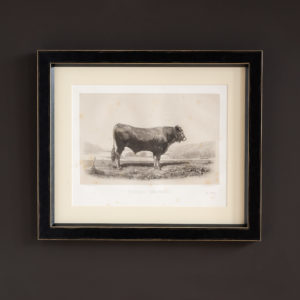
Original lithographs of Cattle Breeds published 1862, ‘Taureau Garonnais’,
£300 eachOriginal lithographs of Cattle Breeds published 1862, ‘Taureau Garonnais’,
Printed by Lemercier of Paris.£300 each -
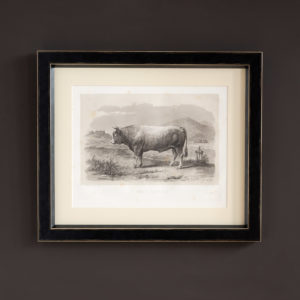
Original lithographs of Cattle Breeds published 1862, ‘Taureau Limousin’,
£300 eachOriginal lithographs of Cattle Breeds published 1862, ‘Taureau Limousin’,
Printed by Lemercier of Paris.£300 each -
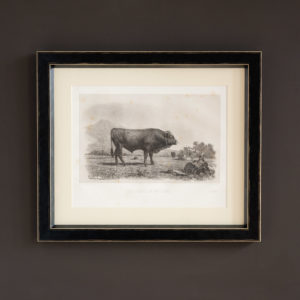
Original lithographs of Cattle Breeds published 1862, ‘Taureau D’Aubrac’,
£300 eachOriginal lithographs of Cattle Breeds published 1862, ‘Taureau D’Aubrac’,
Printed by Lemercier of Paris.£300 each -
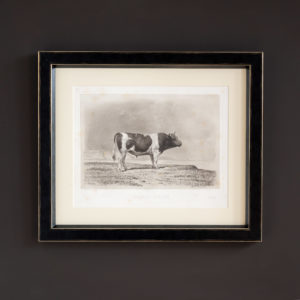
Original lithographs of Cattle Breeds published 1862, ‘Taureau Breton’,
£300 eachOriginal lithographs of Cattle Breeds published 1862, ‘Taureau Breton’,
Printed by Lemercier of Paris.£300 each -
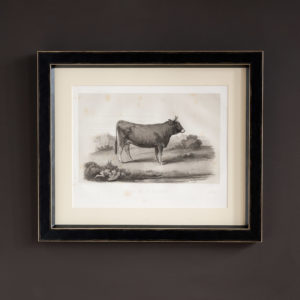
Original lithographs of Cattle Breeds published 1862, ‘Vache D’Aubrac’,
£300 eachOriginal lithographs of Cattle Breeds published 1862, ‘Vache D’Aubrac’,
Printed by Lemercier of Paris.£300 each -
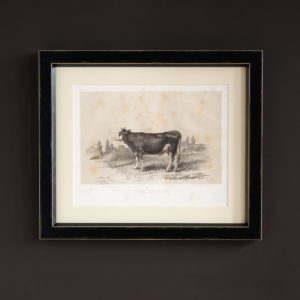
Original lithographs of Cattle Breeds published 1862, ‘Vache Mancelle’,
£300 eachOriginal lithographs of Cattle Breeds published 1862, ‘Vache Mancelle’,
Printed by Lemercier of Paris.£300 each -
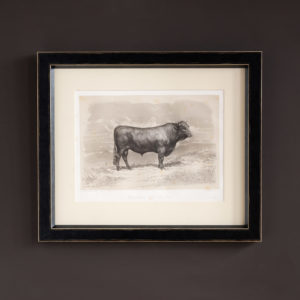
Original lithographs of Cattle Breeds published 1862, ‘Taureau de Salers’,
£300 eachOriginal lithographs of Cattle Breeds published 1862, ‘Taureau de Salers’,
Printed by Lemercier of Paris.£300 each -
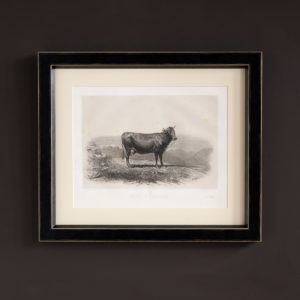
Original lithographs of Cattle Breeds published 1862, ‘Vache D’Oberhasli’,
£300 eachOriginal lithographs of Cattle Breeds published 1862, ‘Vache D’Oberhasli’,
Printed by Lemercier of Paris.£300 each -
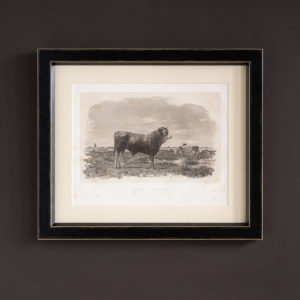
Original lithographs of Cattle Breeds published 1862, ‘Taureau Landais’,
£300 eachOriginal lithographs of Cattle Breeds published 1862, ‘Taureau Landais’,
Printed by Lemercier of Paris.£300 each -
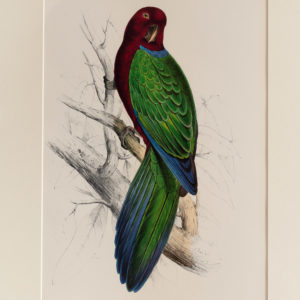
Parrots by Edward Lear – Tabuan Parrakeet,
£275Parrots by Edward Lear – Tabuan Parrakeet,
Edward Lear began his career as a zoological illustrator, working in the Parrot House at London Zoo. This resulted in the publication of Illustrations of the family of Psittacidae, or parrots, the greater part of them species hitherto unfigured in 1832. The first plates for the book were issued in 1830 when he was still only 18.£275 -
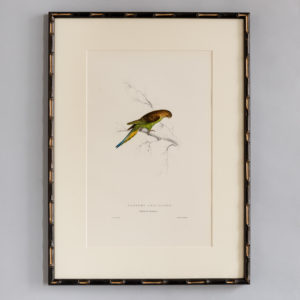
Parrots by Edward Lear – Undulated Parrakeet,
£275Parrots by Edward Lear – Undulated Parrakeet,
Edward Lear began his career as a zoological illustrator, working in the Parrot House at London Zoo. This resulted in the publication of Illustrations of the family of Psittacidae, or parrots, the greater part of them species hitherto unfigured in 1832. The first plates for the book were issued in 1830 when he was still only 18.£275 -
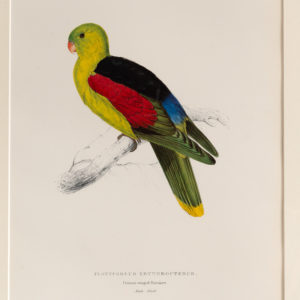
Parrots by Edward Lear – Crimson-winged Parrakeet,
£275Parrots by Edward Lear – Crimson-winged Parrakeet,
Edward Lear began his career as a zoological illustrator, working in the Parrot House at London Zoo. This resulted in the publication of Illustrations of the family of Psittacidae, or parrots, the greater part of them species hitherto unfigured in 1832. The first plates for the book were issued in 1830 when he was still only 18.£275 -
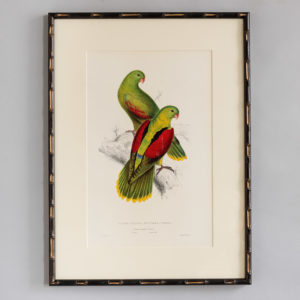
Parrots by Edward Lear – Crimson-winged Parrakeet,
£275Parrots by Edward Lear – Crimson-winged Parrakeet,
Edward Lear began his career as a zoological illustrator, working in the Parrot House at London Zoo. This resulted in the publication of Illustrations of the family of Psittacidae, or parrots, the greater part of them species hitherto unfigured in 1832. The first plates for the book were issued in 1830 when he was still only 18.£275 -
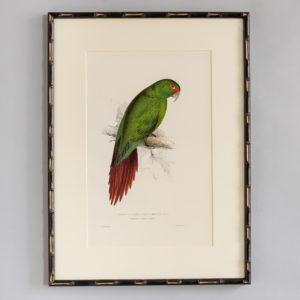
Parrots by Edward Lear – Long-billed Parrakeet-Maccaw,
£275Parrots by Edward Lear – Long-billed Parrakeet-Maccaw,
Edward Lear began his career as a zoological illustrator, working in the Parrot House at London Zoo. This resulted in the publication of Illustrations of the family of Psittacidae, or parrots, the greater part of them species hitherto unfigured in 1832. The first plates for the book were issued in 1830 when he was still only 18.£275 -
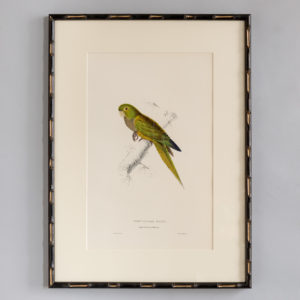
Parrots by Edward Lear – Dwarf Parrakeet Maccaw,
£275Parrots by Edward Lear – Dwarf Parrakeet Maccaw,
Edward Lear began his career as a zoological illustrator, working in the Parrot House at London Zoo. This resulted in the publication of Illustrations of the family of Psittacidae, or parrots, the greater part of them species hitherto unfigured in 1832. The first plates for the book were issued in 1830 when he was still only 18.£275 -
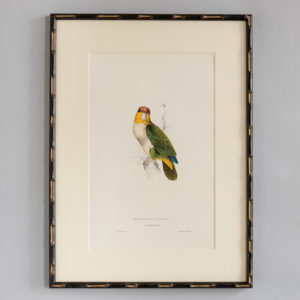
Parrots by Edward Lear – Bay-headed Parrot,
£275Parrots by Edward Lear – Bay-headed Parrot,
Edward Lear began his career as a zoological illustrator, working in the Parrot House at London Zoo. This resulted in the publication of Illustrations of the family of Psittacidae, or parrots, the greater part of them species hitherto unfigured in 1832. The first plates for the book were issued in 1830 when he was still only 18.£275 -
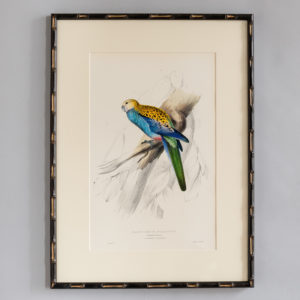
Parrots by Edward Lear – Paleheaded Parrakeet,
£275Parrots by Edward Lear – Paleheaded Parrakeet,
Edward Lear began his career as a zoological illustrator, working in the Parrot House at London Zoo. This resulted in the publication of Illustrations of the family of Psittacidae, or parrots, the greater part of them species hitherto unfigured in 1832. The first plates for the book were issued in 1830 when he was still only 18.£275 -
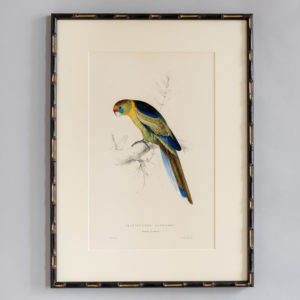
Parrots by Edward Lear – Barnard’s Parrakeet,
£275Parrots by Edward Lear – Barnard’s Parrakeet,
Edward Lear began his career as a zoological illustrator, working in the Parrot House at London Zoo. This resulted in the publication of Illustrations of the family of Psittacidae, or parrots, the greater part of them species hitherto unfigured in 1832. The first plates for the book were issued in 1830 when he was still only 18.£275 -
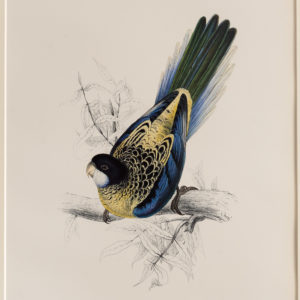
Parrots by Edward Lear – Brown’s Parrakeet,
£275Parrots by Edward Lear – Brown’s Parrakeet,
Edward Lear began his career as a zoological illustrator, working in the Parrot House at London Zoo. This resulted in the publication of Illustrations of the family of Psittacidae, or parrots, the greater part of them species hitherto unfigured in 1832. The first plates for the book were issued in 1830 when he was still only 18.£275 -
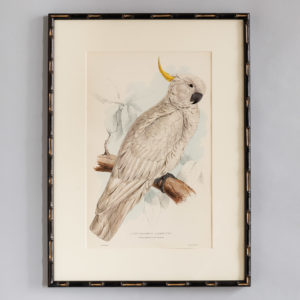
Parrots by Edward Lear – Greater Sulphur-crested Cockatoo,
£275Parrots by Edward Lear – Greater Sulphur-crested Cockatoo,
Edward Lear began his career as a zoological illustrator, working in the Parrot House at London Zoo. This resulted in the publication of Illustrations of the family of Psittacidae, or parrots, the greater part of them species hitherto unfigured in 1832. The first plates for the book were issued in 1830 when he was still only 18.£275 -
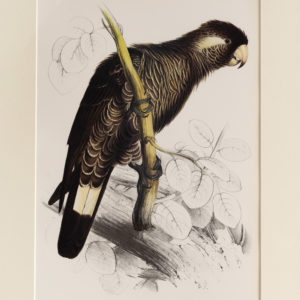
Parrots by Edward Lear – Baudin’s Cockatoo
£275Parrots by Edward Lear – Baudin’s Cockatoo
Edward Lear began his career as a zoological illustrator, working in the Parrot House at London Zoo. This resulted in the publication of Illustrations of the family of Psittacidae, or parrots, the greater part of them species hitherto unfigured in 1832. The first plates for the book were issued in 1830 when he was still only 18.£275 -
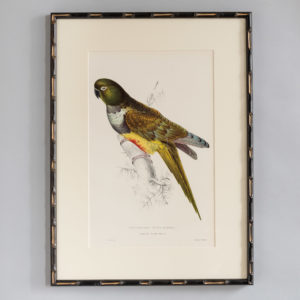
Parrots by Edward Lear – Patagonian Parrakeet-Maccaw
£275Parrots by Edward Lear – Patagonian Parrakeet-Maccaw
Edward Lear began his career as a zoological illustrator, working in the Parrot House at London Zoo. This resulted in the publication of Illustrations of the family of Psittacidae, or parrots, the greater part of them species hitherto unfigured in 1832. The first plates for the book were issued in 1830 when he was still only 18.£275 -
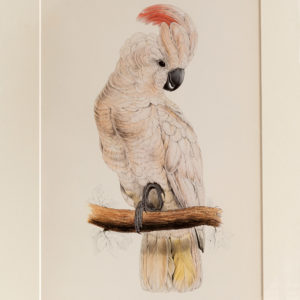
Parrots by Edward Lear – Salmon-crested Cockatoo
£275Parrots by Edward Lear – Salmon-crested Cockatoo
Edward Lear began his career as a zoological illustrator, working in the Parrot House at London Zoo. This resulted in the publication of Illustrations of the family of Psittacidae, or parrots, the greater part of them species hitherto unfigured in 1832. The first plates for the book were issued in 1830 when he was still only 18.£275 -
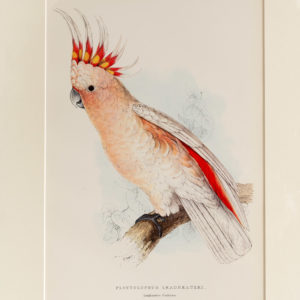
Parrots by Edward Lear – Leadbeater’s Cockatoo,
£275Parrots by Edward Lear – Leadbeater’s Cockatoo,
Edward Lear began his career as a zoological illustrator, working in the Parrot House at London Zoo. This resulted in the publication of Illustrations of the family of Psittacidae, or parrots, the greater part of them species hitherto unfigured in 1832. The first plates for the book were issued in 1830 when he was still only 18.£275 -
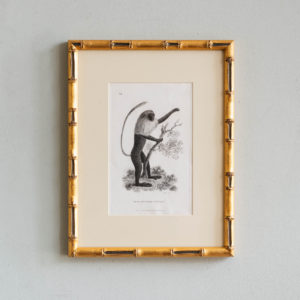
Monkeys – Full-Bottom Monkey,
£260 EachMonkeys – Full-Bottom Monkey,
The English Encyclopaedia was published in 1802 by George Kearsley and it gave an unusual insight into early 19th century new discoveries in zoology.£260 Each -
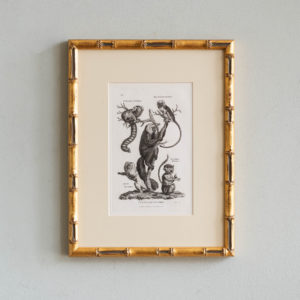
Monkeys – Striated Monkey, Red Tailed-Monkey,
£260 EachMonkeys – Striated Monkey, Red Tailed-Monkey,
The English Encyclopaedia was published in 1802 by George Kearsley and it gave an unusual insight into early 19th century new discoveries in zoology.£260 Each -
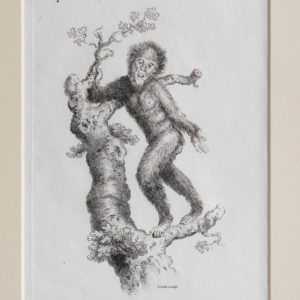
Monkeys – Oran Otan
£260 EachMonkeys – Oran Otan
The English Encyclopaedia was published in 1802 by George Kearsley and it gave an unusual insight into early 19th century new discoveries in zoology.£260 Each -
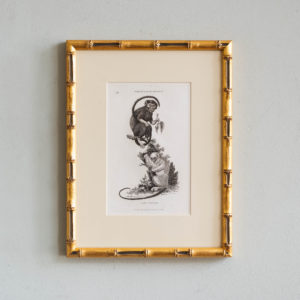
Monkeys – Great-Eared Monkey, and Fair Monkey,
£260 EachMonkeys – Great-Eared Monkey, and Fair Monkey,
The English Encyclopaedia was published in 1802 by George Kearsley and it gave an unusual insight into early 19th century new discoveries in zoology.£260 Each -
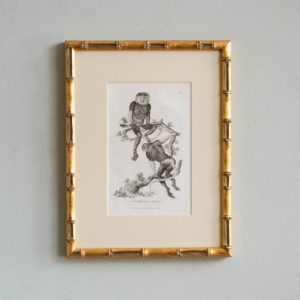
Monkeys – Cochinchina Monkey,
£260 EachMonkeys – Cochinchina Monkey,
The English Encyclopaedia was published in 1802 by George Kearsley and it gave an unusual insight into early 19th century new discoveries in zoology.£260 Each -
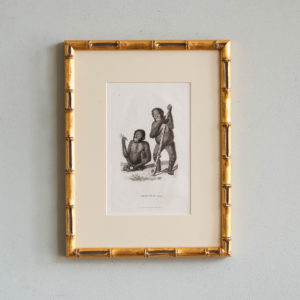
Monkeys – Oran Otan,
£260 EachMonkeys – Oran Otan,
The English Encyclopaedia was published in 1802 by George Kearsley and it gave an unusual insight into early 19th century new discoveries in zoology.£260 Each -
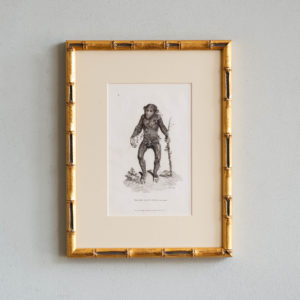
Monkeys – Black Oran-Otan,
£260 EachMonkeys – Black Oran-Otan,
The English Encyclopaedia was published in 1802 by George Kearsley and it gave an unusual insight into early 19th century new discoveries in zoology.£260 Each -
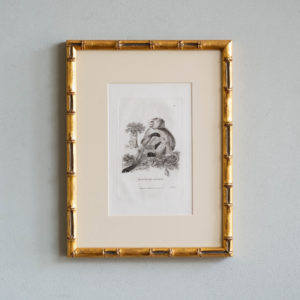
Monkeys – Dog-Faced Baboon,
£260 EachMonkeys – Dog-Faced Baboon,
The English Encyclopaedia was published in 1802 by George Kearsley and it gave an unusual insight into early 19th century new discoveries in zoology.£260 Each -
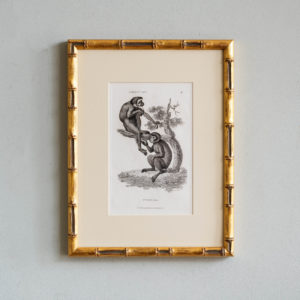
Monkeys – Pygmy Ape, and Alpinus Ape,
£260 EachMonkeys – Pygmy Ape, and Alpinus Ape,
The English Encyclopaedia was published in 1802 by George Kearsley and it gave an unusual insight into early 19th century new discoveries in zoology.£260 Each -
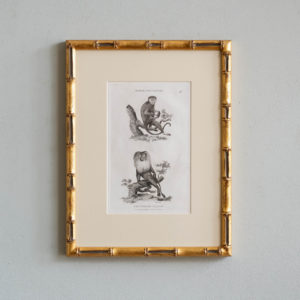
Monkeys – Hare-Lipped Monkey, and Lion-Tailed Monkey,
£260 EachMonkeys – Hare-Lipped Monkey, and Lion-Tailed Monkey,
The English Encyclopaedia was published in 1802 by George Kearsley and it gave an unusual insight into early 19th century new discoveries in zoology.£260 Each -
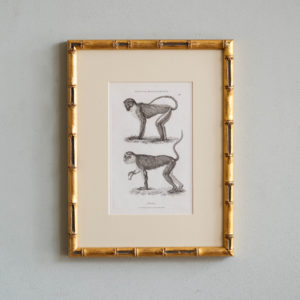
Monkeys – Spotted, or Diana Monkey and Mona,
£260 EachMonkeys – Spotted, or Diana Monkey and Mona,
The English Encyclopaedia was published in 1802 by George Kearsley and it gave an unusual insight into early 19th century new discoveries in zoology.£260 Each -
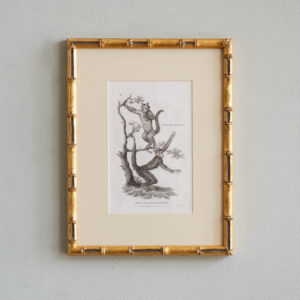
Monkeys – Horned Monkey and Four-Fingered Monkey
£260 EachMonkeys – Horned Monkey and Four-Fingered Monkey
The English Encyclopaedia was published in 1802 by George Kearsley and it gave an unusual insight into early 19th century new discoveries in zoology.£260 Each -
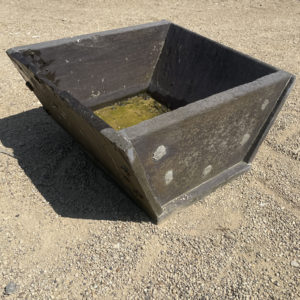
An old slate slab laundry basin
£250 -
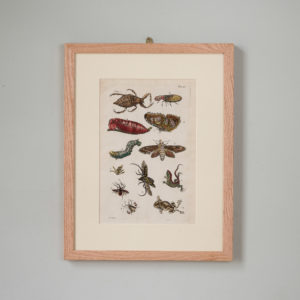
Natural History of Carolina, Florida and the Bahama Islands, published 1729 – 1747.
£225Natural History of Carolina, Florida and the Bahama Islands, published 1729 – 1747.
Mark Catesby was born in Essex to a family owned a farm and house, Holgate, in Sudbury, Suffolk. His acquaintance with the naturalist Reverend John Ray, a leading English naturalist of the late 17th century and co-author of an early classic study on birds started Catesby’s life-long becoming interest in natural history, which he went on to study in London. His life changes when in 1712, he arrived at Williamsburg, Virginia, accompanying his married sister Elizabeth Cocke and two of her children. During his seven-year stay in Virginia that Catesby developed a passionate in the native flora and fauna. He began collecting botanical specimens, especially seeds, and sending them to friends in England and he met William Byrd II, who was an amateur naturalist, a member of the colonial Council and a Fellow of the Royal Society. When he returned to England in 1719, influential members of the Royal Society, then chaired by Sir Isaac Newton, had learned of his work in the colonies. Led by William Sherard, “one of the most celebrated botanists of the age,” members began soliciting sponsors to finance Catesby for a botanical expedition to South Carolina. By 1722, Catesby was again crossing the Atlantic to further his work in the New World. Catesby, was one of the first people to recognize how natural and man-made destruction and depredation of a species’ habitat lead to extinction. He was the first to depict birds, in conjunction with environmentally relevant plants. He returned to England in 1726, and then spent the subsequent two decades years developing his work that would eventually be published as, "The Natural History of Carolina, Florida, and the Bahama Islands" It was first fully illustrated study of the natural history of North America and the most comprehensive to date. Working virtually alone, Catesby personally oversaw every aspect of the work’s production, even learning the difficult art of etching on copper plates. To finance this expensive printing project, Catesby sought subscriptions, offering his book in sections of 20 plates to be published every four months. Published in eleven sections and featuring more than 220 hand-coloured etchings. Published in eleven sections and featuring more than 220 hand-coloured etchings. He personally presented the first section to Her Majesty Queen Caroline in May 1729, and later he dedicated the first volume of the Natural History to her. Following a collapse, Mark Catesby died at his home on Old Street, London, on 23 December 1749, and he was buried in the churchyard of St Luke’s Church£225 -
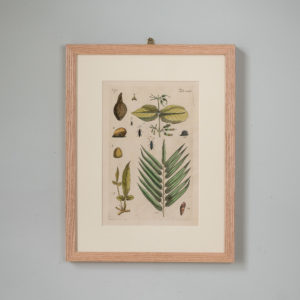
Natural History of Carolina, Florida and the Bahama Islands, published 1729 – 1747.
£225Natural History of Carolina, Florida and the Bahama Islands, published 1729 – 1747.
Mark Catesby was born in Essex to a family owned a farm and house, Holgate, in Sudbury, Suffolk. His acquaintance with the naturalist Reverend John Ray, a leading English naturalist of the late 17th century and co-author of an early classic study on birds started Catesby’s life-long becoming interest in natural history, which he went on to study in London. His life changes when in 1712, he arrived at Williamsburg, Virginia, accompanying his married sister Elizabeth Cocke and two of her children. During his seven-year stay in Virginia that Catesby developed a passionate in the native flora and fauna. He began collecting botanical specimens, especially seeds, and sending them to friends in England and he met William Byrd II, who was an amateur naturalist, a member of the colonial Council and a Fellow of the Royal Society. When he returned to England in 1719, influential members of the Royal Society, then chaired by Sir Isaac Newton, had learned of his work in the colonies. Led by William Sherard, “one of the most celebrated botanists of the age,” members began soliciting sponsors to finance Catesby for a botanical expedition to South Carolina. By 1722, Catesby was again crossing the Atlantic to further his work in the New World. Catesby, was one of the first people to recognize how natural and man-made destruction and depredation of a species’ habitat lead to extinction. He was the first to depict birds, in conjunction with environmentally relevant plants. He returned to England in 1726, and then spent the subsequent two decades years developing his work that would eventually be published as, "The Natural History of Carolina, Florida, and the Bahama Islands" It was first fully illustrated study of the natural history of North America and the most comprehensive to date. Working virtually alone, Catesby personally oversaw every aspect of the work’s production, even learning the difficult art of etching on copper plates. To finance this expensive printing project, Catesby sought subscriptions, offering his book in sections of 20 plates to be published every four months. Published in eleven sections and featuring more than 220 hand-coloured etchings. Published in eleven sections and featuring more than 220 hand-coloured etchings. He personally presented the first section to Her Majesty Queen Caroline in May 1729, and later he dedicated the first volume of the Natural History to her. Following a collapse, Mark Catesby died at his home on Old Street, London, on 23 December 1749, and he was buried in the churchyard of St Luke’s Church£225 -
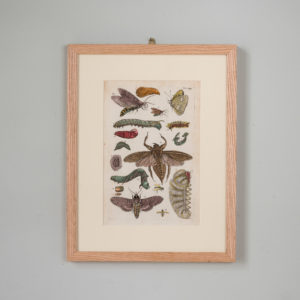
Natural History of Carolina, Florida and the Bahama Islands, published 1729 – 1747.
£225Natural History of Carolina, Florida and the Bahama Islands, published 1729 – 1747.
Mark Catesby was born in Essex to a family owned a farm and house, Holgate, in Sudbury, Suffolk. His acquaintance with the naturalist Reverend John Ray, a leading English naturalist of the late 17th century and co-author of an early classic study on birds started Catesby’s life-long becoming interest in natural history, which he went on to study in London. His life changes when in 1712, he arrived at Williamsburg, Virginia, accompanying his married sister Elizabeth Cocke and two of her children. During his seven-year stay in Virginia that Catesby developed a passionate in the native flora and fauna. He began collecting botanical specimens, especially seeds, and sending them to friends in England and he met William Byrd II, who was an amateur naturalist, a member of the colonial Council and a Fellow of the Royal Society. When he returned to England in 1719, influential members of the Royal Society, then chaired by Sir Isaac Newton, had learned of his work in the colonies. Led by William Sherard, “one of the most celebrated botanists of the age,” members began soliciting sponsors to finance Catesby for a botanical expedition to South Carolina. By 1722, Catesby was again crossing the Atlantic to further his work in the New World. Catesby, was one of the first people to recognize how natural and man-made destruction and depredation of a species’ habitat lead to extinction. He was the first to depict birds, in conjunction with environmentally relevant plants. He returned to England in 1726, and then spent the subsequent two decades years developing his work that would eventually be published as, "The Natural History of Carolina, Florida, and the Bahama Islands" It was first fully illustrated study of the natural history of North America and the most comprehensive to date. Working virtually alone, Catesby personally oversaw every aspect of the work’s production, even learning the difficult art of etching on copper plates. To finance this expensive printing project, Catesby sought subscriptions, offering his book in sections of 20 plates to be published every four months. Published in eleven sections and featuring more than 220 hand-coloured etchings. Published in eleven sections and featuring more than 220 hand-coloured etchings. He personally presented the first section to Her Majesty Queen Caroline in May 1729, and later he dedicated the first volume of the Natural History to her. Following a collapse, Mark Catesby died at his home on Old Street, London, on 23 December 1749, and he was buried in the churchyard of St Luke’s Church£225 -
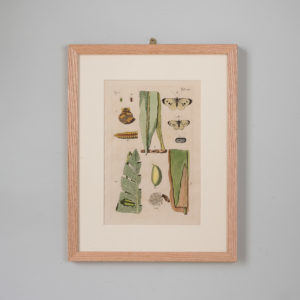
Natural History of Carolina, Florida and the Bahama Islands, published 1729 – 1747.
£225Natural History of Carolina, Florida and the Bahama Islands, published 1729 – 1747.
Mark Catesby was born in Essex to a family owned a farm and house, Holgate, in Sudbury, Suffolk. His acquaintance with the naturalist Reverend John Ray, a leading English naturalist of the late 17th century and co-author of an early classic study on birds started Catesby’s life-long becoming interest in natural history, which he went on to study in London. His life changes when in 1712, he arrived at Williamsburg, Virginia, accompanying his married sister Elizabeth Cocke and two of her children. During his seven-year stay in Virginia that Catesby developed a passionate in the native flora and fauna. He began collecting botanical specimens, especially seeds, and sending them to friends in England and he met William Byrd II, who was an amateur naturalist, a member of the colonial Council and a Fellow of the Royal Society. When he returned to England in 1719, influential members of the Royal Society, then chaired by Sir Isaac Newton, had learned of his work in the colonies. Led by William Sherard, “one of the most celebrated botanists of the age,” members began soliciting sponsors to finance Catesby for a botanical expedition to South Carolina. By 1722, Catesby was again crossing the Atlantic to further his work in the New World. Catesby, was one of the first people to recognize how natural and man-made destruction and depredation of a species’ habitat lead to extinction. He was the first to depict birds, in conjunction with environmentally relevant plants. He returned to England in 1726, and then spent the subsequent two decades years developing his work that would eventually be published as, "The Natural History of Carolina, Florida, and the Bahama Islands" It was first fully illustrated study of the natural history of North America and the most comprehensive to date. Working virtually alone, Catesby personally oversaw every aspect of the work’s production, even learning the difficult art of etching on copper plates. To finance this expensive printing project, Catesby sought subscriptions, offering his book in sections of 20 plates to be published every four months. Published in eleven sections and featuring more than 220 hand-coloured etchings. Published in eleven sections and featuring more than 220 hand-coloured etchings. He personally presented the first section to Her Majesty Queen Caroline in May 1729, and later he dedicated the first volume of the Natural History to her. Following a collapse, Mark Catesby died at his home on Old Street, London, on 23 December 1749, and he was buried in the churchyard of St Luke’s Church£225 -
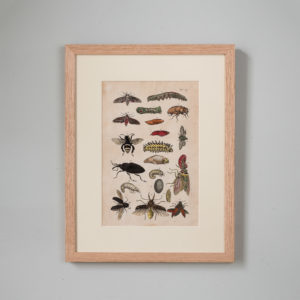
Natural History of Carolina, Florida and the Bahama Islands, published 1729 – 1747.
£225Natural History of Carolina, Florida and the Bahama Islands, published 1729 – 1747.
Mark Catesby was born in Essex to a family owned a farm and house, Holgate, in Sudbury, Suffolk. His acquaintance with the naturalist Reverend John Ray, a leading English naturalist of the late 17th century and co-author of an early classic study on birds started Catesby’s life-long becoming interest in natural history, which he went on to study in London. His life changes when in 1712, he arrived at Williamsburg, Virginia, accompanying his married sister Elizabeth Cocke and two of her children. During his seven-year stay in Virginia that Catesby developed a passionate in the native flora and fauna. He began collecting botanical specimens, especially seeds, and sending them to friends in England and he met William Byrd II, who was an amateur naturalist, a member of the colonial Council and a Fellow of the Royal Society. When he returned to England in 1719, influential members of the Royal Society, then chaired by Sir Isaac Newton, had learned of his work in the colonies. Led by William Sherard, “one of the most celebrated botanists of the age,” members began soliciting sponsors to finance Catesby for a botanical expedition to South Carolina. By 1722, Catesby was again crossing the Atlantic to further his work in the New World. Catesby, was one of the first people to recognize how natural and man-made destruction and depredation of a species’ habitat lead to extinction. He was the first to depict birds, in conjunction with environmentally relevant plants. He returned to England in 1726, and then spent the subsequent two decades years developing his work that would eventually be published as, "The Natural History of Carolina, Florida, and the Bahama Islands" It was first fully illustrated study of the natural history of North America and the most comprehensive to date. Working virtually alone, Catesby personally oversaw every aspect of the work’s production, even learning the difficult art of etching on copper plates. To finance this expensive printing project, Catesby sought subscriptions, offering his book in sections of 20 plates to be published every four months. Published in eleven sections and featuring more than 220 hand-coloured etchings. Published in eleven sections and featuring more than 220 hand-coloured etchings. He personally presented the first section to Her Majesty Queen Caroline in May 1729, and later he dedicated the first volume of the Natural History to her. Following a collapse, Mark Catesby died at his home on Old Street, London, on 23 December 1749, and he was buried in the churchyard of St Luke’s Church£225 -
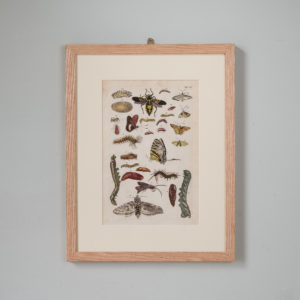
Natural History of Carolina, Florida and the Bahama Islands, published 1729 – 1747.
£225Natural History of Carolina, Florida and the Bahama Islands, published 1729 – 1747.
Mark Catesby was born in Essex to a family owned a farm and house, Holgate, in Sudbury, Suffolk. His acquaintance with the naturalist Reverend John Ray, a leading English naturalist of the late 17th century and co-author of an early classic study on birds started Catesby’s life-long becoming interest in natural history, which he went on to study in London. His life changes when in 1712, he arrived at Williamsburg, Virginia, accompanying his married sister Elizabeth Cocke and two of her children. During his seven-year stay in Virginia that Catesby developed a passionate in the native flora and fauna. He began collecting botanical specimens, especially seeds, and sending them to friends in England and he met William Byrd II, who was an amateur naturalist, a member of the colonial Council and a Fellow of the Royal Society. When he returned to England in 1719, influential members of the Royal Society, then chaired by Sir Isaac Newton, had learned of his work in the colonies. Led by William Sherard, “one of the most celebrated botanists of the age,” members began soliciting sponsors to finance Catesby for a botanical expedition to South Carolina. By 1722, Catesby was again crossing the Atlantic to further his work in the New World. Catesby, was one of the first people to recognize how natural and man-made destruction and depredation of a species’ habitat lead to extinction. He was the first to depict birds, in conjunction with environmentally relevant plants. He returned to England in 1726, and then spent the subsequent two decades years developing his work that would eventually be published as, "The Natural History of Carolina, Florida, and the Bahama Islands" It was first fully illustrated study of the natural history of North America and the most comprehensive to date. Working virtually alone, Catesby personally oversaw every aspect of the work’s production, even learning the difficult art of etching on copper plates. To finance this expensive printing project, Catesby sought subscriptions, offering his book in sections of 20 plates to be published every four months. Published in eleven sections and featuring more than 220 hand-coloured etchings. Published in eleven sections and featuring more than 220 hand-coloured etchings. He personally presented the first section to Her Majesty Queen Caroline in May 1729, and later he dedicated the first volume of the Natural History to her. Following a collapse, Mark Catesby died at his home on Old Street, London, on 23 December 1749, and he was buried in the churchyard of St Luke’s Church£225 -
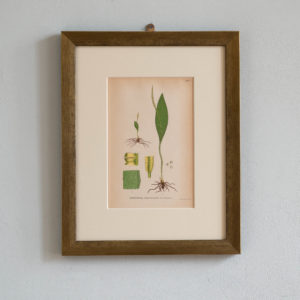
Natural History, Original Fern Prints based on the Work of Carl Lindman. ‘Ophioglossum Vulgatum’.
£220Natural History, Original Fern Prints based on the Work of Carl Lindman. ‘Ophioglossum Vulgatum’.
Carl Axel Magnus Lindman was a Swedish botanist and botanical artist, who published "Bilder ur Nordens Flora" between 1901-1905.£220 -
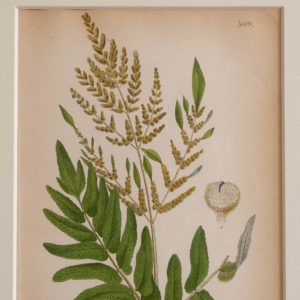
Natural History, Original Fern Prints based on the Work of Carl Lindman. ‘Osmunda Regalis.
£220Natural History, Original Fern Prints based on the Work of Carl Lindman. ‘Osmunda Regalis.
Carl Axel Magnus Lindman was a Swedish botanist and botanical artist, who published "Bilder ur Nordens Flora" between 1901-1905.£220 -
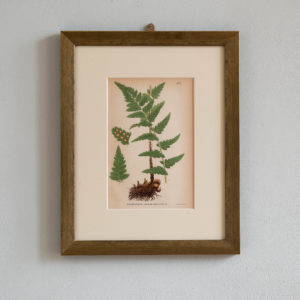
Natural History, Original Fern Prints based on the Work of Carl Lindman. ‘Aspidium Cristatum’,
£220Natural History, Original Fern Prints based on the Work of Carl Lindman. ‘Aspidium Cristatum’,
Carl Axel Magnus Lindman was a Swedish botanist and botanical artist, who published "Bilder ur Nordens Flora" between 1901-1905.£220 -
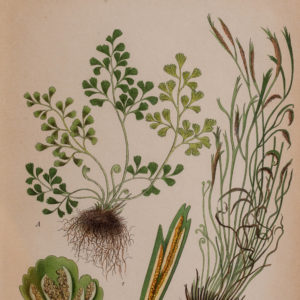
Natural History, Original Fern Prints based on the Work of Carl Lindman. ‘Asplenium Septentrionale’.
£220Natural History, Original Fern Prints based on the Work of Carl Lindman. ‘Asplenium Septentrionale’.
Carl Axel Magnus Lindman was a Swedish botanist and botanical artist, who published "Bilder ur Nordens Flora" between 1901-1905.£220 -
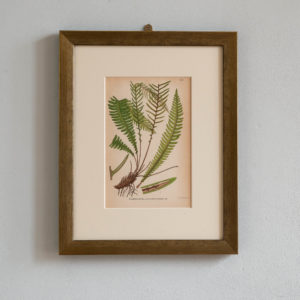
Natural History, Original Fern Prints based on the Work of Carl Lindman. ‘Blechnum Spicant’,
£220Natural History, Original Fern Prints based on the Work of Carl Lindman. ‘Blechnum Spicant’,
Carl Axel Magnus Lindman was a Swedish botanist and botanical artist, who published "Bilder ur Nordens Flora" between 1901-1905.£220 -
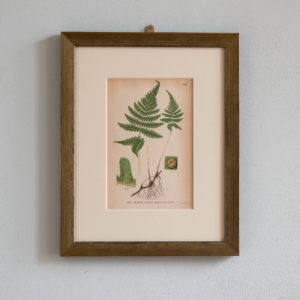
Natural History, Original Fern Prints based on the Work of Carl Lindman. ‘Aspidium Phegopteris’,
£220Natural History, Original Fern Prints based on the Work of Carl Lindman. ‘Aspidium Phegopteris’,
Carl Axel Magnus Lindman was a Swedish botanist and botanical artist, who published "Bilder ur Nordens Flora" between 1901-1905.£220 -
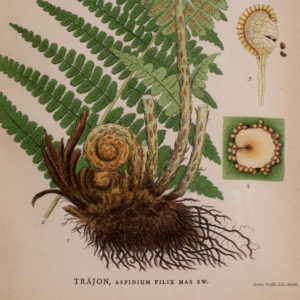
Natural History, Original Fern Prints based on the Work of Carl Lindman. ‘Aspidium Filix’,
£220Natural History, Original Fern Prints based on the Work of Carl Lindman. ‘Aspidium Filix’,
Carl Axel Magnus Lindman was a Swedish botanist and botanical artist, who published "Bilder ur Nordens Flora" between 1901-1905.£220 -
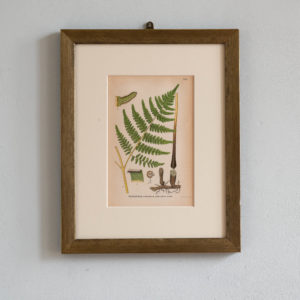
Natural History, Original Fern Prints based on the Work of Carl Lindman. ‘Pteridium Aquilinum’,
£220Natural History, Original Fern Prints based on the Work of Carl Lindman. ‘Pteridium Aquilinum’,
Carl Axel Magnus Lindman was a Swedish botanist and botanical artist, who published "Bilder ur Nordens Flora" between 1901-1905.£220 -
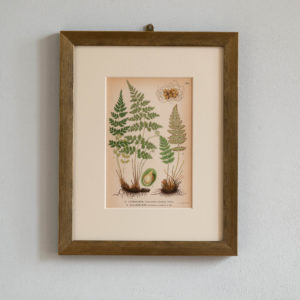
Natural History, Original Fern Prints based on the Work of Carl Lindman. ‘Woodsia Ilvensis’,
£220Natural History, Original Fern Prints based on the Work of Carl Lindman. ‘Woodsia Ilvensis’,
Carl Axel Magnus Lindman was a Swedish botanist and botanical artist, who published "Bilder ur Nordens Flora" between 1901-1905.£220 -
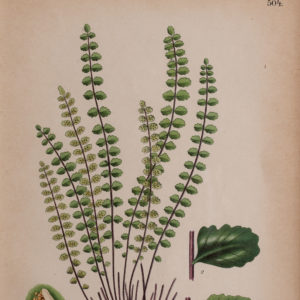
Natural History, Original Fern Prints based on the Work of Carl Lindman. ‘Asplenium Trichomanes’
£220Natural History, Original Fern Prints based on the Work of Carl Lindman. ‘Asplenium Trichomanes’
Carl Axel Magnus Lindman was a Swedish botanist and botanical artist, who published "Bilder ur Nordens Flora" between 1901-1905.£220 -
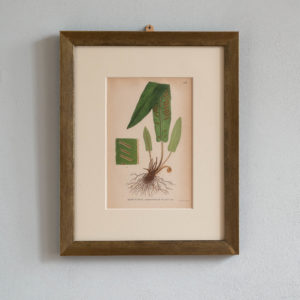
Natural History, Original Fern Prints based on the Work of Carl Lindman. ‘Scolopendrium Vulgare’,
£220Natural History, Original Fern Prints based on the Work of Carl Lindman. ‘Scolopendrium Vulgare’,
Carl Axel Magnus Lindman was a Swedish botanist and botanical artist, who published "Bilder ur Nordens Flora" between 1901-1905.£220 -
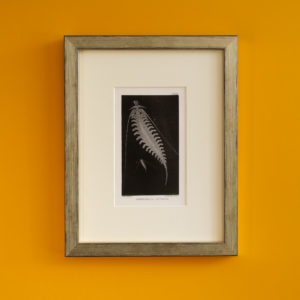
Naturalist Rambles on the Devonshire Coast, by Philip Henry Gosse. ‘Johnstonella Catharina’,
£220Naturalist Rambles on the Devonshire Coast, by Philip Henry Gosse. ‘Johnstonella Catharina’,
Living in London, Gosse's prodigious hobby of publishing work on his observations resulted in a breakdown from overwork. He was advised to go and live in the country and moved to Devon in 1853 where he wrote 'A naturalist's rambles on the Devonshire coast' The book successfully popularised the science of marine biology, but his reputation as a serious scientist later suffered with the publication of 'Omphalo' in which he refuted developmental theory, aiming to reconcile geology with the Bible's account of creation.£220 -
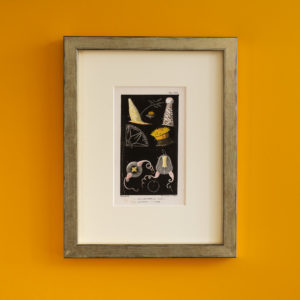
Naturalist Rambles on the Devonshire Coast, by Philip Henry Gosse. ‘Balanophylia Regia, Saphenia Titania’,
£220Naturalist Rambles on the Devonshire Coast, by Philip Henry Gosse. ‘Balanophylia Regia, Saphenia Titania’,
Living in London, Gosse's prodigious hobby of publishing work on his observations resulted in a breakdown from overwork. He was advised to go and live in the country and moved to Devon in 1853 where he wrote 'A naturalist's rambles on the Devonshire coast' The book successfully popularised the science of marine biology, but his reputation as a serious scientist later suffered with the publication of 'Omphalo' in which he refuted developmental theory, aiming to reconcile geology with the Bible's account of creation.£220 -
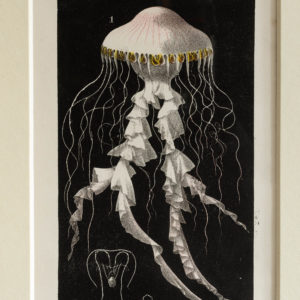
Naturalist Rambles on the Devonshire Coast, by Philip Henry Gosse. ‘Chrysaora Cyclonota’,
£220Naturalist Rambles on the Devonshire Coast, by Philip Henry Gosse. ‘Chrysaora Cyclonota’,
Living in London, Gosse's prodigious hobby of publishing work on his observations resulted in a breakdown from overwork. He was advised to go and live in the country and moved to Devon in 1853 where he wrote 'A naturalist's rambles on the Devonshire coast' The book successfully popularised the science of marine biology, but his reputation as a serious scientist later suffered with the publication of 'Omphalo' in which he refuted developmental theory, aiming to reconcile geology with the Bible's account of creation.£220 -
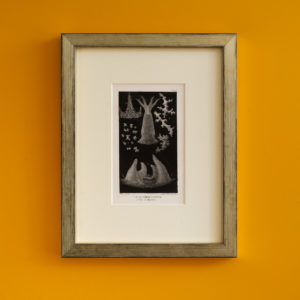
Naturalist Rambles on the Devonshire Coast, by Philip Henry Gosse. ‘Alcyonium Digitatum, Eye of Parten’,
£220Naturalist Rambles on the Devonshire Coast, by Philip Henry Gosse. ‘Alcyonium Digitatum, Eye of Parten’,
Living in London, Gosse's prodigious hobby of publishing work on his observations resulted in a breakdown from overwork. He was advised to go and live in the country and moved to Devon in 1853 where he wrote 'A naturalist's rambles on the Devonshire coast' The book successfully popularised the science of marine biology, but his reputation as a serious scientist later suffered with the publication of 'Omphalo' in which he refuted developmental theory, aiming to reconcile geology with the Bible's account of creation.£220 -
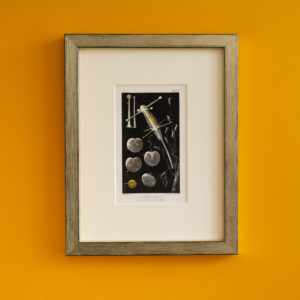
Naturalist Rambles on the Devonshire Coast, by Philip Henry Gosse. ‘Coryne Staurdial, Noctiluca Miliaris’,’,
£220Naturalist Rambles on the Devonshire Coast, by Philip Henry Gosse. ‘Coryne Staurdial, Noctiluca Miliaris’,’,
Living in London, Gosse's prodigious hobby of publishing work on his observations resulted in a breakdown from overwork. He was advised to go and live in the country and moved to Devon in 1853 where he wrote 'A naturalist's rambles on the Devonshire coast' The book successfully popularised the science of marine biology, but his reputation as a serious scientist later suffered with the publication of 'Omphalo' in which he refuted developmental theory, aiming to reconcile geology with the Bible's account of creation.£220 -
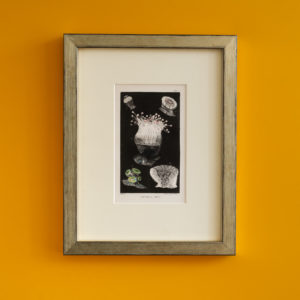
Naturalist Rambles on the Devonshire Coast, by Philip Henry Gosse. ‘Caryophyllia Smithii’,
£220Naturalist Rambles on the Devonshire Coast, by Philip Henry Gosse. ‘Caryophyllia Smithii’,
Living in London, Gosse's prodigious hobby of publishing work on his observations resulted in a breakdown from overwork. He was advised to go and live in the country and moved to Devon in 1853 where he wrote 'A naturalist's rambles on the Devonshire coast' The book successfully popularised the science of marine biology, but his reputation as a serious scientist later suffered with the publication of 'Omphalo' in which he refuted developmental theory, aiming to reconcile geology with the Bible's account of creation.£220 -
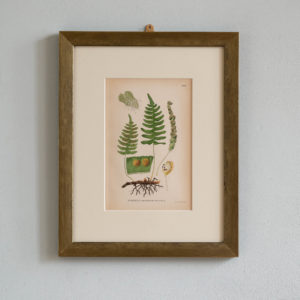
Natural History, Original Fern Prints based on the Work of Carl Lindman. ‘Polypdodium Vulgare’,
£220Natural History, Original Fern Prints based on the Work of Carl Lindman. ‘Polypdodium Vulgare’,
Carl Axel Magnus Lindman was a Swedish botanist and botanical artist, who published "Bilder ur Nordens Flora" between 1901-1905.£220 -
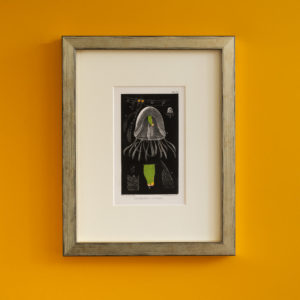
Naturalist Rambles on the Devonshire Coast, by Philip Henry Gosse. Thaumantias Corynetes,
£220Naturalist Rambles on the Devonshire Coast, by Philip Henry Gosse. Thaumantias Corynetes,
Living in London, Gosse's prodigious hobby of publishing work on his observations resulted in a breakdown from overwork. He was advised to go and live in the country and moved to Devon in 1853 where he wrote 'A naturalist's rambles on the Devonshire coast' The book successfully popularised the science of marine biology, but his reputation as a serious scientist later suffered with the publication of 'Omphalo' in which he refuted developmental theory, aiming to reconcile geology with the Bible's account of creation.£220
Featured Items
-
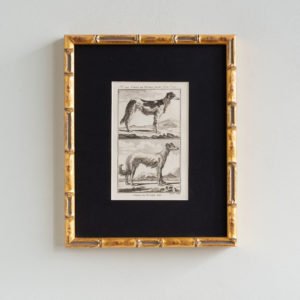
18th Century French Engravings of Dogs
£175 each18th Century French Engravings of Dogs
Published for, Histoire naturelle, générale et particulière (1749–1804), which was the first modern attempt to systematically present all existing knowledge in the fields of natural history, geology, and anthropology.£175 each -
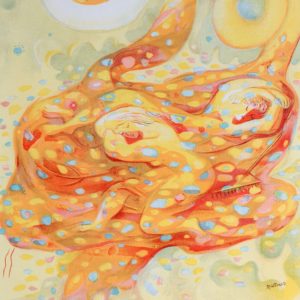
Autumn by Abraham Rattner, Verve Vol. 1 / No. 3.
£600Autumn by Abraham Rattner, Verve Vol. 1 / No. 3.
The Verve Review was a purposefully luxurious. It ran from 1937 to 1960, but with only 38 editions available, due to the high degree of design and editorial work dedicated to each issue. Each edition contained unique lithographic prints, commissioned by the editor, and each cover a double-page lithograph elaborated by one of the artists contained within. It was the brainchild of its editor Stratis Eleftheriades, a Greek National who moved to Paris in the early thirties to take part in the growing Modernist movement, writing under the name of Teriade.£600 -
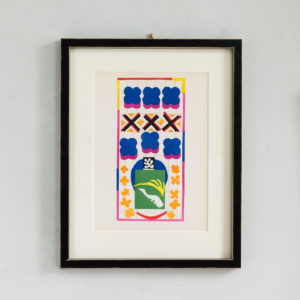
Henri Matisse, ‘The Last Works of Henri Matisse’
£900 eachHenri Matisse, ‘The Last Works of Henri Matisse’
From Verve Vol. IX No. 35/36 published by Tériade under the title 'The Last Works of Henri Matisse'£900 each -
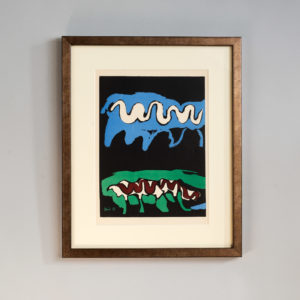
The Four Elements, Earth by Francisco Bores, Verve Vol. 1 / No. 1.
£600The Four Elements, Earth by Francisco Bores, Verve Vol. 1 / No. 1.
The Verve Review was a purposefully luxurious. It ran from 1937 to 1960, but with only 38 editions available, due to the high degree of design and editorial work dedicated to each issue. Each edition contained unique lithographic prints, commissioned by the editor, and each cover a double-page lithograph elaborated by one of the artists contained within. It was the brainchild of its editor Stratis Eleftheriades, a Greek National who moved to Paris in the early thirties to take part in the growing Modernist movement, writing under the name of Teriade.£600

